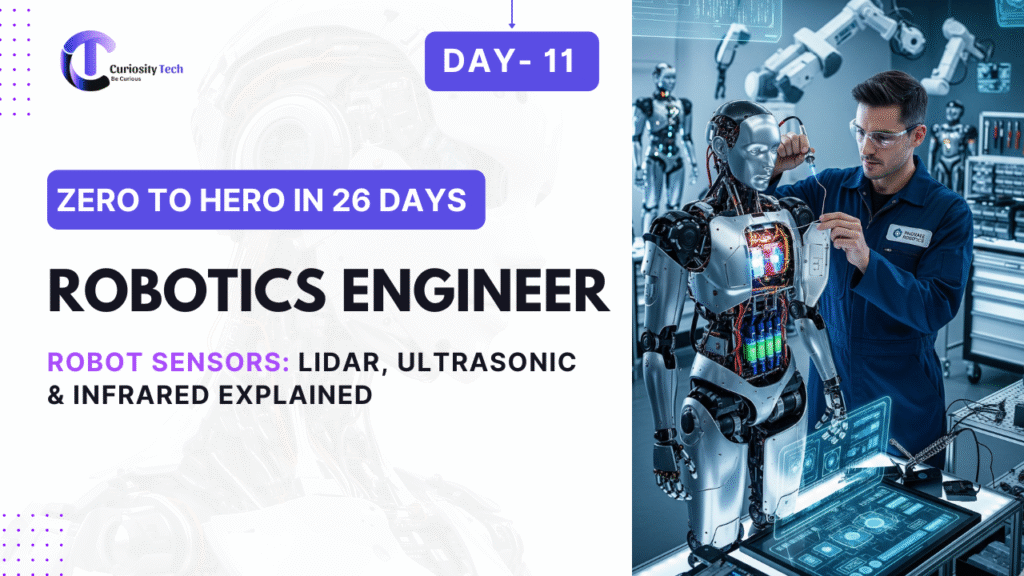Introduction
Sensors are the eyes and ears of a robot, enabling it to perceive its environment and make intelligent decisions. Among the most widely used sensors in robotics are LiDAR, Ultrasonic, and Infrared (IR) sensors, each offering unique advantages and use cases. Understanding these sensors in depth is essential for robotics engineers aiming to design autonomous and efficient robotic systems.
At CuriosityTech.in, learners gain access to hands-on tutorials, simulation projects, and practical experiments to master these sensors for real-world robotics applications.
1. LiDAR Sensors
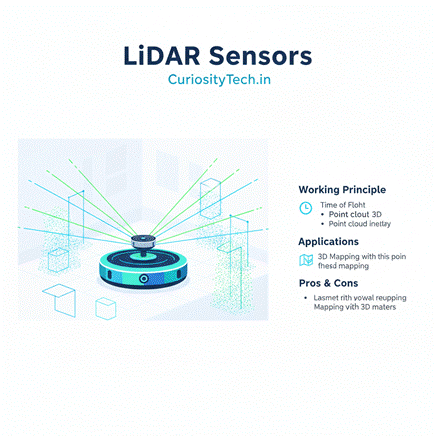
LiDAR (Light Detection and Ranging) uses laser beams to measure distances by calculating the time taken for light to reflect from surfaces.
Working Principle:
- Emit a laser pulse.
- Measure the time until the pulse reflects back.
Compute distance using the formula:
Distance = (Speed of Light × Time of Flight) / 2
- Rotate or scan to generate a 2D or 3D map of the environment.
Applications:
- Autonomous navigation in mobile robots and drones.
- 3D mapping of environments (SLAM).
- Obstacle detection for industrial robots.
Pros:
- High accuracy (millimeter-level precision).
- Works over long distances.
- Generates high-resolution maps.
Cons:
- Expensive compared to other sensors.
- Performance affected by reflective or transparent surfaces.
Diagram Idea: LiDAR mounted on a mobile robot scanning surroundings with a 360° field of view, showing reflected laser points forming a point cloud.
2. Ultrasonic Sensors
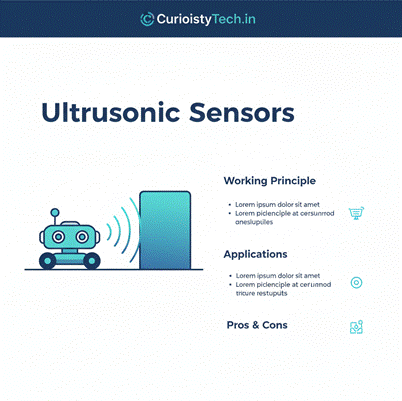
Ultrasonic sensors measure distance using high-frequency sound waves.
Working Principle:
- Emit an ultrasonic pulse.
- Wait for the echo to return after bouncing off an object.
Calculate distance:
Distance = (Speed of Sound × Time of Flight) / 2
Applications:
- Obstacle detection in mobile robots.
- Parking sensors in autonomous vehicles.
- Water level monitoring in industrial robots.
Pros:
- Cost-effective.
- Easy to interface with microcontrollers (Arduino, Raspberry Pi).
- Reliable for short-range obstacle detection.
Cons:
- Limited range compared to LiDAR.
- Affected by soft or angled surfaces.
- Slower response in dynamic environments.
Diagram Idea: Mobile robot with forward-facing ultrasonic sensors detecting a nearby obstacle.
3. Infrared (IR) Sensors
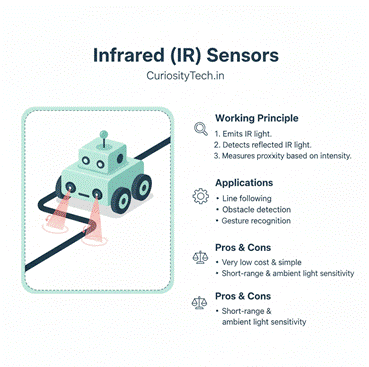
Infrared sensors detect objects by sensing IR radiation or reflection. They can be proximity sensors, distance sensors, or line sensors.
Working Principle:
- Emit infrared light toward the target.
- Detect the reflected IR light with a photodiode or phototransistor.
- Measure proximity or presence based on reflected intensity.
Applications:
- Line-following robots using IR reflection.
- Obstacle detection for small robots.
- Gesture recognition and human-robot interaction.
Pros:
- Very low cost.
- Simple to implement.
- Works well for close-range applications.
Cons:
- Short-range detection (typically under 20–30 cm).
- Affected by ambient light conditions.
- Cannot measure precise distances over long ranges.
Diagram Idea: Line-following robot with IR sensors detecting black lines on a white surface.
4. Comparative Table: LiDAR vs Ultrasonic vs IR Sensors
| Feature | LiDAR | Ultrasonic | Infrared (IR) |
| Range | 0.1m – 200m | 2cm – 400cm | 1cm – 30cm |
| Accuracy | High (mm-level) | Moderate (cm-level) | Low to moderate |
| Field of View | 360° (rotating) | Narrow (~15–30°) | Narrow (~10–15°) |
| Cost | High | Low | Very Low |
| Best Use Case | Mapping, autonomous navigation | Obstacle detection, short-range navigation | Line following, proximity detection |
| Response Speed | Fast | Moderate | Fast |
| Environmental Sensitivity | Reflective surfaces, dust | Soft surfaces, temperature | Ambient light, surface color |
5. Sensor Integration in Robotics
Robots often combine multiple sensors to achieve robust perception:
Example: Autonomous Mobile Robot:
- LiDAR: Builds a 3D map and detects long-range obstacles.
- Ultrasonic: Detects nearby obstacles for immediate response.
- IR Sensors: Detect edges or lines for guidance in tight spaces.
Diagram Idea: Mobile robot with labeled sensors showing overlapping detection zones for LiDAR, ultrasonic, and IR sensors.
6. Beginner Project Example: Obstacle Avoiding Robot
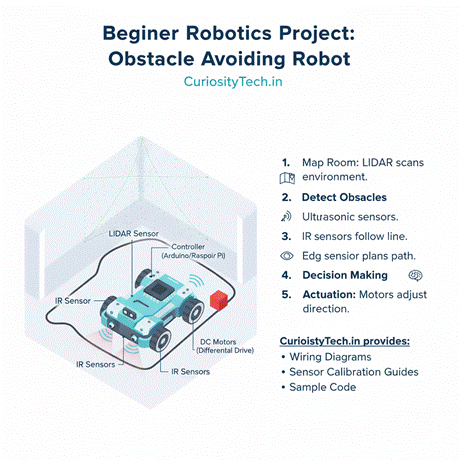
Objective: Build a robot that navigates a room while avoiding obstacles.
Components:
- Controller: Arduino or Raspberry Pi.
- Sensors: 1 LiDAR for mapping, 2 Ultrasonic sensors for side obstacle detection, 2 IR sensors for edge detection.
- Actuators: DC motors for differential drive.
Step-by-Step Implementation:
- Map Room: Use LiDAR to scan obstacles and create a basic map.
- Detect Obstacles: Ultrasonic sensors detect objects in the path.
- Edge Detection: IR sensors prevent the robot from falling or crossing boundaries.
- Decision Making: Controller computes new path using sensor data.
- Actuation: Motors adjust direction to avoid obstacles.
CuriosityTech.in provides detailed wiring diagrams, sensor calibration guides, and sample code for such projects.
7. Tips for Mastering Sensors in Robotics
- Learn the working principles and limitations of each sensor.
- Start with single-sensor projects before combining multiple sensors.
- Calibrate sensors accurately for better performance.
- Use sensor fusion techniques to improve robustness and reliability.
- Test sensors in simulation platforms (Gazebo/V-REP) before deploying in hardware.
Conclusion
LiDAR, Ultrasonic, and Infrared sensors form the backbone of robotic perception systems, each serving a unique purpose. Understanding their working principles, strengths, limitations, and integration techniques enables robotics engineers to design autonomous systems that navigate safely and intelligently. Platforms like CuriosityTech.in provide hands-on tutorials, projects, and simulation guides that make learning and mastering these sensors accessible and practical for aspiring robotics engineers.

